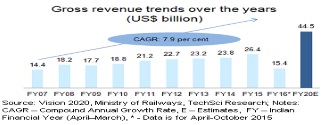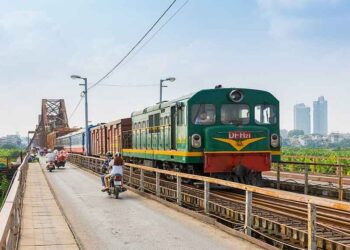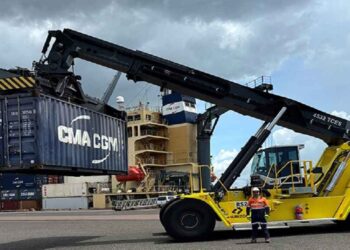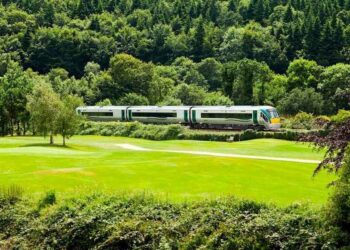Introduction
The Indian Railways is among the world’s largest. Spread across 7,146 stations, the 64,600-km network enables the running of 19,000 trains on a daily basis. India’s railway network is recognised as one of the largest railway systems in the world under single management.
The railway network is also ideal for long-distance travel and movement of bulk commodities, apart from being an energy efficient and economic mode of conveyance and transport.
The Government of India has focused on investing on railway infrastructure by making investor-friendly policies. It has moved quickly to enable foreign direct investment (FDI) in railways to improve infrastructure for freight and high-speed trains. At present, several domestic and foreign companies are also looking to invest in Indian rail projects.
Market size
The total approximate earnings of Indian Railways on originating basis during FY2014-15 were Rs 157,880 crore (US$ 23.68 billion) compared to Rs 140,761 crore (US$ 21.11 billion) during the same period last year, registering an increase of 12.16 per cent.
The total approximate earnings from goods during fiscal 2014-15 were Rs 107,074.79 crore (US$ 16.06 billion) compared to Rs 94,955.89 crore (US$ 14.24 billion) during the same period last year, registering an increase of 12.76 per cent.
The total approximate revenue earnings from passengers during the financial year 2014-15 were Rs 42,866.33 crore (US$ 6.43 billion) compared to Rs 37,478.34 crore (US$ 5.6 billion) during the same period last year, registering an increase of 14.38 percent.
The total approximate revenue earnings from other coaching amounted to Rs 4,035.56 crore (US$ 605 million) during fiscal 2014-15 compared to Rs 3,818.03 crore (US$ 572 million) during the same period last year, registering an increase of 5.7 per cent.
The total approximate numbers of passengers booked during the financial year 2014-15 were 8,227.99 million compared to 8,425.09 million during the same period last year, showing a decrease of 2.34 per cent. In the suburban and non-suburban sectors, the numbers of passengers booked during fiscal 2014-15 were 4,503.97 million and 3,724.02 million compared to 4,549.62 million and 3875.47 million registering a decrease of 1 per cent and 3.91 per cent respectively during the same period last year.
Currently, Indian Railways is focusing on finishing the capacity-augmentation projects that have the highest rates of return. There are 154 New Line, 42 Gauge Conversion, 166 Doubling and 54 Railway Electrification projects across the country with throw forward of Rs 285,652 crore (US$ 42.87 billion). For Railway Electrification projects, the throw forward as on April 1, 2014 had been estimated to be Rs 6,692 crore (US$ 1.0 billion).
Investments/Developments
Foreign direct investment (FDI) inflows into railway related components from April 2000 to September 2015 were US$ 652.2 million.
Following are some of the major investments and developments in India’s railways sector:
Japan has offered to provide loan at less than one per cent interest rate for India’s first bullet train between Mumbai and Ahmedabad costing US$ 15 billion, on the condition that India buys 30 per cent of equipment from Japanese firms.
The Madhya Pradesh government has obtained Rs 12,000 crore (US$ 1.85 billion) loan from Japan International Cooperation Agency (JICA) for its Bhopal and Indore Metro rail projects.
Indian Railways has issued a Letter of Award (LoA) to US-based General Electric (GE) for a Rs 14,656 crore (US$ 2.2 billion) diesel locomotive factory project at Marhowra, and to French transport major Alstom for Rs 20,000 crore (US$ 3 billion) electric locomotive project in Madhepura, both in the state of Bihar.
The Government of India will be spending Rs 850,000 crore (US$ 127.62 billion) over the next five years to modernize Indian Railways for which they have received a 30 year loan from LIC. The Cabinet also cleared the Rs 82,000 crore (US$ 12.3 billion) dedicated freight corridor for decongesting existing network.
A memorandum of understanding (MoU) was signed between the Ministry of Railways and Life Insurance Corporation (LIC) in the presence of the Minister of Finance Mr Arun Jaitley and the Minister of Railways Mr Suresh Prabhu. Under this MoU, LIC will make available to the Ministry of Railways/its entities a financial assistance with a limit of Rs 150,000 crore (US$ 22.52 billion) over the next five years for implementing Railway projects.
Encouraging private sector participation in Railways, Mr Suresh Prabhu, in his maiden Railway Budget, amalgamated public welfare with private investment. While investment through public-private partnerships (PPP) was increased to Rs 5,781 crore (US$ 867.94 million), several schemes for improving efficiency of the Railways were kept under this head.
With the objective of cutting energy costs, the Indian Railways has signed a bilateral power procurement agreement with the Damodar Valley Corporation (DVC). Under the agreement, railways will buy 50 MW of power from DVC at Auraiya Grid Sub-station facilitated by Railways Energy Management Co. Ltd, a joint venture of the Indian Railways and RITES, a public sector unit of the Ministry of Railways.
The Ministry of Railways has sanctioned implementation of Eastern Dedicated Freight Corridor (EDFC) and Western Dedicated Freight Corridor (WDFC) with freight train speeds of maximum 100 Kmph.
The Government of India sanctioned Rs 1,000 crore (US$ 150.14 million) for a 15 km railway project connecting India and Bangladesh linking Agartala in Tripura and Akhaura in Bangladesh.
Government Initiatives
Minister of Railways Mr Suresh Prabhu has said that the Ministry of Finance has communicated a Gross Budgetary Support of Rs 40,000 crore (US$ 6.01 billion) for the Railway’s annual plan. Presenting the Railway Budget 2015-16 in Parliament, Railway Minister Mr Suresh Prabhu said Rs 1,645.6 crore (US$ 247.06 million) has also been provided as Railway’s share of diesel cess from the Central Road Fund.
The Ministry of Railways is focusing on its massive US$ 140 billion investment plan to modernise the railways and improve safety, performance and passenger amenities, as per Railways Minister Mr Suresh Prabhu.
The Ministry of Railways in November 2014 issued Sectoral Guidelines for permitting domestic/foreign direct investment (FDI) in construction, operation and maintenance in the following identified areas:-
i) Suburban corridors through public private partnership (PPP), ii) high speed train projects, iii) dedicated freight lines iv) rolling stock including trains sets and locomotive/coaches manufacturing and maintenance facilities v) railway electrification vi) signalling system vii) freight terminals viii) passenger terminals ix) testing facilities and laboratories x) non-conventional sources of energy xi) railways technical training institutes xii) concessioning of standalone passenger corridors (branch lines, hill railways etc.) Xiii) mechanised laundry, xiv) rolling stock procurement, xv) bio-toilets, xvi) technological solution for manned and unmanned level crossings, xvii) technological solutions to improve safety and reduce accidents. The guidelines will encourage foreign investors for making investment under ‘Make in India’ programme. An ‘Investors Meet’ was also held in December 2014 to encourage foreign investors in making investments.
According to Mr N Sreekumar, Chief General Manager of Container Corporation of India Limited, the Indian Railways is coming out with a new rating system. Addressing an event organised by Indian Institute of Logistics, Mr Sreekumar said the government is going to restructure the railway board. He also stated that the total logistics sector in India would undergo a transformation with the east and west freight corridor coming into being.
Promising “watershed development” of Indian Railways, Minister of Railways Mr Suresh Prabhu announced a series of reforms in the rail sector, including the introduction of remote sensing technology to improve safety, rail bookings on mobile phones and wi-fi at railway stations.
During first seven months of FY 2015-16, Indian Railways awarded projects worth Rs 10,594 crore (US$ 1.59 billion), more than double the value of those awarded in the same period last year. Most of these projects involve engineering, procurement and construction (EPC) contracts.
State government of Maharashtra has planned to set up a Special Purpose Vehicle (SPV), Maharashtra Railway Infrastructure Development Company, with a view to ensure that the various development projects are completed in a time bound manner.
A memorandum of understanding (MoU) and an Action Plan have been signed between the Government of India and the Government of China to improve technical cooperation in the railways sector, at delegation level talks between the two countries. Prime Minister Mr Narendra Modi and the visiting President of China, Xi Jinping, were present at the signing.
In August, an MoU was signed between the Ministry of Railways in India and the Czech Railways (Ceske Drahy) and Association of Czech Railway Industry (ACRI) of the Czech Republic on technical cooperation in the field of the railways sector.
The Government of India has cleared a proposal to allow 100 per cent FDI in railway infrastructure, barring operations, via the automatic route. FDI channelled through this route does not require prior government approvals.
The Railway Board is considering the implementation of the 106 recommendations of the High Level Safety Review Committee (Kakodkar Committee) pertaining to general safety matters, empowerment at working level, vacancies in critical safety category, organisational structure, shortage of critical safety spares, human resource development with focus on education and training research, among others.
The Union Cabinet has given its approval for establishing a new rail coach manufacturing unit at Kolar, Karnataka. The unit will produce 500 coaches per annum at a projected cost of Rs 1,460.92 crore (US$ 219.34 million). The Ministry of Railways will provide 50 per cent of the finances with the Karnataka government providing land, free of cost, and the remaining 50 per cent of the project completion cost with escalation.

































